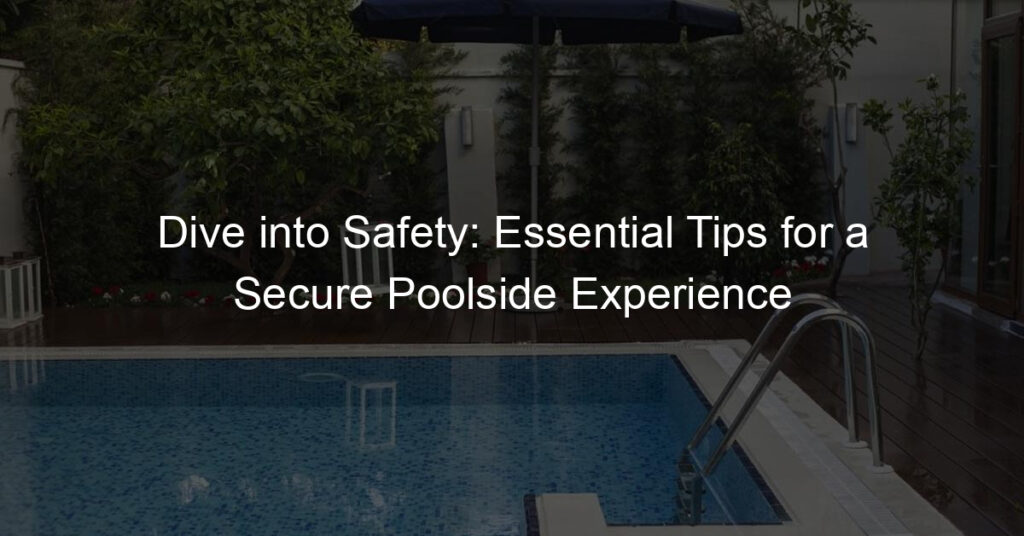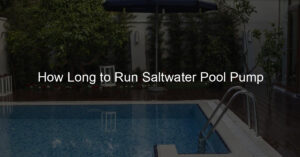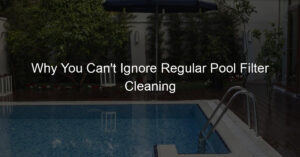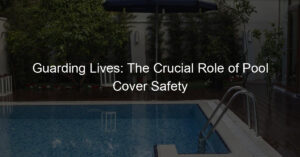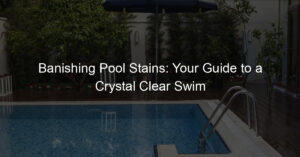Introduction to Pool Safety
Swimming pools can be a source of joy and relaxation, especially during the hot summer months. However, they also pose certain risks if not used safely. This section will delve into the importance of pool safety, the potential risks associated with pools, and the benefits of maintaining a safe swimming environment.
-
- Importance of Swimming Pool Safety
Swimming pool safety is crucial for everyone, regardless of age. According to the Centers for Disease Control and Prevention, approximately ten people die from unintentional drowning every day. Out of these, two are children aged 14 or younger. Therefore, understanding and implementing pool safety measures can significantly reduce the risk of accidents and ensure a safe and enjoyable swimming experience for all.
-
- Understanding the Risks Associated with Pools
Several risks are associated with swimming pools. These include drowning, slips and falls, and injuries from diving or jumping in shallow water. Additionally, improperly balanced pool chemicals can cause skin and eye irritation or respiratory problems. Understanding these risks is the first step towards creating a safer swimming environment.
-
- Benefits of a Safe Swimming Environment
A safe swimming environment not only reduces the risk of accidents but also promotes a more enjoyable experience for everyone. When safety measures are in place, parents can feel more at ease while their children play, and swimmers of all ages can enjoy the water without fear. Furthermore, a well-maintained pool can enhance the overall health and well-being of the swimmers by providing a great way to exercise and relax.
In the following sections, we will provide practical tips on how to ensure pool safety, discuss child pool safety, explore various pool safety equipment, and provide guidelines for safe swimming. We will also discuss how to maintain a safe pool and the precautions to take to ensure pool safety. Stay tuned to learn more about this important topic.
Pool Safety Tips
When it comes to pool safety, there are several general guidelines that everyone should follow to ensure a safe and enjoyable swimming experience. These tips are not only crucial for maintaining safety but also for preventing accidents that can lead to serious injuries.
General Pool Safety Tips
Here are some general safety tips that you should always keep in mind:
- Always supervise children: Never leave children unattended near or in a pool. Drowning can occur quickly and silently, even in shallow water. It’s essential to keep a constant eye on children to ensure their safety.
- Learn CPR and first aid: Knowing how to perform cardiopulmonary resuscitation (CPR) and first aid can be a lifesaver in an emergency. These skills are vital for anyone who spends time near a pool, especially if children are present.
- Keep pool area clear of toys when not in use: Toys can attract children to the pool area and can be a tripping hazard. Always clean up after swimming to prevent accidents and keep the area safe.
Remember, safety should always be your top priority when enjoying time by the pool. By following these tips, you can help ensure a safe and fun environment for everyone.
Residential Pool Safety
Ensuring safety around your residential pool is of utmost importance. Here are some key steps you can take to maintain a safe environment around your pool.
-
- Install a fence around the pool
A fence around your pool can serve as the first line of defense against accidents. It can prevent unsupervised access to the pool, especially by young children. The fence should be at least four feet high and have a self-closing, self-latching gate. This simple measure can significantly reduce the risk of drowning incidents.
-
- Use pool covers
When the pool is not in use, a pool cover can provide an extra layer of safety. It can prevent accidental falls into the water and also keep the pool clean by preventing debris from entering. Remember, pool covers are not a substitute for active supervision or a safety fence, but they can serve as an additional safety measure.
-
- Regular maintenance and cleaning
Keeping your pool clean and well-maintained is a critical aspect of pool safety. Regular maintenance includes checking the pool’s chemical balance, cleaning the pool and filter, and inspecting the pool area for any potential hazards. A well-maintained pool can prevent health issues and accidents caused by slippery surfaces or malfunctioning equipment.
In conclusion, residential pool safety is a responsibility that should be taken seriously. By following these tips, you can ensure a safe and enjoyable swimming environment for everyone.
Child Pool Safety
When it comes to pool safety, children require special attention. It’s crucial to equip them with the right skills and knowledge to ensure they can enjoy the water safely. Let’s explore some key aspects of child pool safety.
-
Importance of Swimming Lessons for Children
Swimming lessons are a vital part of child pool safety. According to the American Academy of Pediatrics, children who have had formal swimming instruction are 88% less likely to drown. Swimming lessons teach children how to tread water, float, and exit the pool safely. They also instill a healthy respect for water and its potential dangers. Therefore, it’s recommended to start swimming lessons as early as age 1.
-
Use of Flotation Devices
Flotation devices can be a useful tool in teaching children how to swim and keeping them safe in the water. However, they should never be used as a substitute for supervision. Devices like arm floaties, pool noodles, and life vests can provide an added layer of safety. Remember, these devices are not life-saving equipment and should only be used under adult supervision.
-
Teaching Children Pool Rules
Teaching children the rules of the pool is another essential aspect of child pool safety. Some important rules to teach your children include:
- No running around the pool area
- Never swim alone
- Always wait for an adult before going in the water
- Never dive in shallow water
By teaching these rules and ensuring they are followed, you can significantly reduce the risk of pool-related accidents.
In conclusion, child pool safety is a multifaceted approach that involves swimming lessons, the use of flotation devices, and teaching pool rules. By implementing these strategies, we can ensure our children enjoy the water in a safe and secure manner.
Pool Safety Equipment
When it comes to keeping your pool safe, there are several pieces of equipment that can help. These tools are designed to prevent accidents and ensure that if something does happen, you’re prepared to handle it. Let’s take a closer look at some of the most important pool safety equipment.
-
- Life jackets and floatation devices
Life jackets and floatation devices are essential for pool safety, especially for children and those who are not strong swimmers. They help the wearer to stay afloat, reducing the risk of drowning. According to the U.S. Coast Guard, life jackets have been credited with saving thousands of lives each year. It’s important to ensure that these devices are U.S. Coast Guard-approved and fit the wearer properly.
-
- Pool alarms
Pool alarms are another important piece of safety equipment. They can alert you if someone or something enters the pool unexpectedly, giving you the chance to respond quickly. There are different types of pool alarms, including surface wave detection alarms, underwater movement alarms, and gate or door alarms. Each type has its own advantages and can provide an additional layer of protection for your pool.
-
- Rescue equipment
Having rescue equipment on hand is crucial in case of an emergency. This can include items such as a life hook, a life ring, or a reaching pole. These tools can help you pull someone out of the water quickly and safely. The American Red Cross recommends having these items readily available and in good working condition.
In conclusion, investing in the right pool safety equipment can make a big difference in preventing accidents and responding effectively when they occur. Remember, safety should always be your top priority when enjoying your pool.
Swimming Safety Guidelines
Swimming is a fun and healthy activity for people of all ages. However, it’s crucial to follow certain safety guidelines to ensure a safe and enjoyable experience. Let’s delve into some safe swimming practices that everyone should adhere to.
Safe Swimming Practices
Here are some fundamental swimming safety rules that everyone should follow:
- Never swim alone: No matter how experienced you are, always swim with a buddy. Accidents can happen to anyone, and having someone nearby can make a significant difference in an emergency. According to the American Red Cross, swimming with a buddy can reduce the risk of drowning.
- Follow pool rules and signs: Pool rules and signs are there for a reason. They provide important safety information, such as the depth of the pool, prohibited activities, and emergency procedures. Ignoring these rules can lead to accidents.
- Avoid alcohol and drugs when swimming: Alcohol and drugs can impair your judgment, coordination, and ability to swim. They can also increase your risk of injury or drowning. The Centers for Disease Control and Prevention (CDC) states that alcohol is involved in up to 70% of deaths associated with water recreation.
By adhering to these safety practices, you can ensure a safe and enjoyable swimming experience. Remember, safety should always be your top priority when engaging in any water-related activities.
Emergency Procedures
When it comes to swimming, safety is paramount. Knowing what to do in an emergency can mean the difference between life and death. Here are some emergency procedures you should be familiar with:
- What to do in case of drowningIf someone is drowning, the first step is to get them out of the water as quickly and safely as possible. Once they are out of the water, check if they are breathing. If they are not, start performing chest compressions and rescue breaths, also known as CPR (Cardiopulmonary Resuscitation). Remember, the key is to stay calm and act quickly.
- First aid proceduresFirst aid is a crucial skill to have when dealing with pool emergencies. It involves steps like cleaning wounds to prevent infection, applying bandages, and knowing how to treat minor injuries like sprains and strains. It’s also important to know how to perform CPR, as mentioned above. Taking a first aid course can equip you with these lifesaving skills.
- When to call for helpIt’s important to call for professional help as soon as possible in any emergency situation. If someone is unconscious, not breathing, or seriously injured, call your local emergency number immediately. Even if you’re not sure if it’s a real emergency, it’s better to be safe than sorry. Remember, every second counts in an emergency.
These emergency procedures are crucial to ensuring safety when swimming. It’s important to be prepared and know what to do in case of an emergency. Remember, safety first!
Maintaining a Safe Pool
Keeping your pool safe is not just about preventing accidents. It also involves ensuring that the pool environment is clean and healthy. Here are three key areas to focus on:
-
- Regular Pool Maintenance
Regular maintenance is the first step to a safe pool. This involves skimming off leaves and debris, brushing the sides and bottom of the pool, and vacuuming. A clean pool is not only more inviting but also reduces the risk of slipping or tripping over unseen objects. Regularly check and clean the pool filter as well. A clogged filter can lead to poor water circulation, making the pool unsafe for swimming.
-
- Checking for Hazards
Regularly inspect your pool area for potential hazards. This includes checking for slippery surfaces, sharp objects, and broken pool equipment. Ensure that the pool ladder or steps are secure and not wobbly. The pool deck should be free of toys or other objects that could cause someone to trip and fall into the pool. If you have a pool cover, make sure it is properly secured and does not have any rips or tears that could trap a swimmer.
-
- Ensuring Water Quality
Water quality is crucial for a safe swimming experience. Regularly test your pool water for the correct chemical levels. This includes chlorine, which kills bacteria and other harmful organisms, and pH, which should be kept between 7.2 and 7.8 for optimal disinfection and comfort. High levels of chemicals can cause skin and eye irritation, while low levels can allow harmful bacteria to thrive. Consider using a professional pool service for accurate testing and treatment.
In conclusion, maintaining a safe pool involves regular cleaning, checking for hazards, and ensuring good water quality. By following these steps, you can provide a safe and enjoyable swimming environment for everyone.
Pool Safety Precactions
When it comes to pool safety, it’s crucial to take certain precautions. These measures are designed to prevent accidents and ensure everyone can enjoy the pool safely. Let’s explore three key areas: preventing slips and falls, proper storage of pool chemicals, and electrical safety near pools.
-
- Preventing Slips and Falls
Slips and falls are the most common pool-related accidents. To prevent these, ensure the pool area is free from wet and slippery surfaces. Use non-slip mats around the pool and encourage everyone to walk, not run. According to the Centers for Disease Control and Prevention, over 200,000 people visit the emergency room each year due to injuries from pool-related falls. By taking these simple steps, we can significantly reduce this number.
-
- Proper Storage of Pool Chemicals
Pool chemicals, if not stored correctly, can pose a significant risk. These chemicals should always be kept out of reach of children and pets. They should be stored in a cool, dry place, away from direct sunlight and other substances that could cause a reaction. Remember, pool chemicals can cause burns, respiratory problems, and other serious health issues if mishandled. The U.S. Consumer Product Safety Commission reports that improper handling of pool chemicals leads to thousands of visits to the emergency room each year.
-
- Electrical Safety Near Pools
Water and electricity are a dangerous combination. To ensure electrical safety near pools, all electrical devices should be kept at a safe distance from the water. This includes pool lights, pumps, and heaters. All electrical installations should be done by a licensed electrician and regularly inspected for any signs of wear and tear. The Electrical Safety Foundation International states that electrical accidents around pools are often fatal, so this is a precaution we cannot afford to overlook.
In conclusion, pool safety is a serious matter that requires our constant attention. By taking these precautions, we can ensure a safe and enjoyable pool experience for everyone.
Conclusion: The Importance of Pool Safety
As we conclude, it’s vital to re-emphasize the importance of pool safety. It’s not just about having fun in the water; it’s also about ensuring everyone’s well-being. Pool safety is a responsibility we all share.
-
- Reiteration of the importance of pool safety
Pool safety is not a topic to be taken lightly. Each year, according to the Centers for Disease Control and Prevention, about ten people die from unintentional drowning every day. Of these, two are children aged 14 or younger. This statistic alone highlights the importance of pool safety. It’s not just about rules and regulations; it’s about protecting lives. We’ve discussed various aspects of pool safety, from safety tips and equipment to precautions and guidelines. Remember, a safe pool is a fun pool.
-
- Final thoughts and recommendations
As we wrap up, we recommend that every pool owner and user take pool safety seriously. Equip your pool with the necessary safety equipment, follow the guidelines and precautions, and ensure children are always supervised. It’s also crucial to maintain your pool regularly to prevent accidents caused by faulty equipment or poor water conditions. Pool safety is a continuous effort, not a one-time task. Let’s make every swim safe and enjoyable.
In conclusion, pool safety is a crucial aspect of enjoying your pool. It ensures that everyone can have fun without worrying about potential dangers. Remember, safety first!

